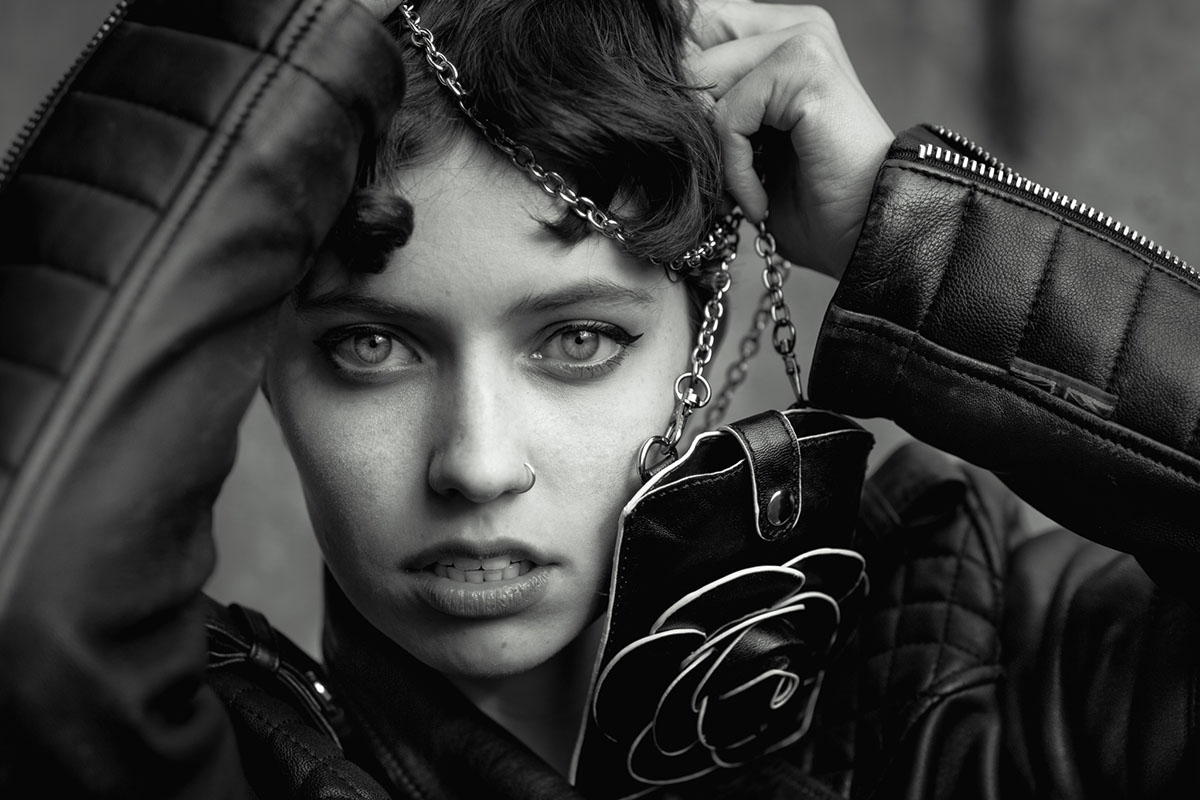Students Behind the Lens: Connor Williams
An English lit major who hopes to one day venture into photojournalism, Connor Williams shoots through glass, harnesses the wind, and shoots at high noon to create portraits with vulnerability.
By Jenn Gidman
Images by Connor Williams
When Connor Williams first started classes at New Jersey's Raritan Valley Community College, he signed up for a black-and-white photography course, and he almost dropped it when he heard what would be involved. "It was a five-hour class every week, and we were told we'd be spending five to seven additional hours in the darkroom outside of class," he says. "I dreaded it, but I ended up loving the darkroom. I was in there eight hours a day sometimes. I got hooked."
Connor started off taking pictures of landscapes, both natural and industrial, as his father had done as a film photographer in the '80s. "I'd look at my dad's old slides and try to emulate them," he says. "I fell into portraits from there by accident, starting with some photos I took of a girl I was going out with at the time. They were awful pictures, but they're still among my favorites because I remember spending so much time developing them and trying to fix them. I put a lot of time into those photos, because I wanted them perfect, because I was in love with that girl, and that process taught me so much."
The next day in class, after Connor had developed the photos, the course instructor told the students to study a specific photographer. "I came across the work of Yousuf Karsh, an Armenian-Canadian photographer who took famous black-and-white portraits of Winston Churchill and Albert Einstein, among others," Connor says. "I took one of those photos and compared it to the pictures I'd just taken and I saw a lot of similarities. Something just clicked inside me right then; I knew I wanted to go in the portrait direction."
Today Connor is an English lit major at RVCC, doing fashion and editorial photography on the side and hoping to one day venture into photojournalism. "I took a break last semester, because I couldn't focus on school, and I used that break to hone my photography skills," he says. "Now I'm back at school while still trying to perfect my craft."
Connor couldn't afford some of the more expensive lenses geared toward portraiture on the market, but then he spied the Tamron SP 45mm F/1.8 VC lens. "On a crop sensor camera, that extends to 85mm, which to me is the perfect focal length for portraits," he says. "I picked one up, fell in love with it, and still consider it my favorite lens to this day. It's sharp as a tack—you can see the ripples in my subject's iris from 5 feet away. The contrast and color tones are right where I want them, too; the 45mm doesn't oversaturate colors like some lenses. Plus I shoot completely handheld, so the 45's Vibration Compensation (VC) feature is indispensable. I don't think I've ever had a bad moment with this lens."
When he's creating editorial-style work, Connor focuses on color theory and composition. "I try to accentuate not only the beauty and look of the person in front of me, but also the person's clothing or whatever other product I'm trying to promote," he says. "Otherwise, if it's just beauty or candid shots, all I do is make the person as comfortable as possible by prompting conversation, then try to capture a moment of true emotion and vulnerability."
Although many photographers prefer the beginning and end of the day to take their pictures, Connor feels differently. "The so-called golden hour is sometimes too yellow for me," he says. "And I just don't like the blue hour, for some reason, even though in general I like cooler-toned pictures." And those times were often out for him anyway when he was just learning how to take pictures, because he usually had to work around not just his own work and school schedules, but also those of his models.
"On some days, my choice would be to shoot from noon to 1 p.m. or from 11 p.m. to midnight," he laughs. And so his favorite shooting time become one that emerged out of necessity: high noon, on overcast days if he could swing it. "High noon just helps me be more creative," he says. "At first I had no idea how to shoot in those conditions. But you learn. I spent hours upon hours on YouTube and reading books, looking at different types of photos. Then, when I'd go out to take pictures, I'd seek out shade or other types of softer light, or wait for a cloud to cover the sun. I'd use extreme highlights to my advantage and create a weirdly artistic photo where most of it was blown out except for a part of the face. I learned to expect the worst, hope for the best, and be adaptable."
The light Connor finds dictates how he directs his subjects. "It's an organic process, depending on where the light is coming from, and what kind of light it is," he says. "I'll first have my subject stand in front of me and see where the light falls. Then I'll have them move a bit clockwise or counterclockwise until the shadows are cast exactly the way I want them to be. Finally, I'll tweak their positioning just a bit by moving their head slightly so they don't have a double chin, for instance, or to highlight certain features."
Trying to capture a portrait directly head-on isn't typically one of Connor's goals. "In my images, the lens isn't completely on the same plane as the person's face or eyes," he says. "It's subtle, but I'm always a bit lower or a bit higher—just enough to offer a slight perspective difference. You don't notice it consciously, but subconsciously it spurs an emotion."
Using techniques he picked up from watching plenty of movies, where he does end up shooting from depends on what mood or feeling he's trying to convey. "If I shoot from below looking up at my subject, I give that person a whole lot more power," he says. "If I shoot looking down at them, the viewer will see them as weaker and more vulnerable.
Connor explains that, although he doesn't like to overedit or overprocess—"I try not to change the colors too much"—working on one of his images in post-production can take anywhere from a couple of minutes to a couple of hours. "I don't like to edit so much that it looks like a fake photo," he says. "But I do like to make sure the image is just right. That means I'll brighten up the eyes and face, take out any acne, correct the exposure, and tweak the colors to fit my Instagram feed or just my style in general. Knowing and understanding color theory in photography has proved huge for me. It's opened my eyes to so many things and brought my work to a new level."
Connor will convert to black and white for one of three reasons. The first is if the colors are boring or don't otherwise add anything to the photo. The second? "If something goes wrong, like the image is blown out in the highlights or is too dark," he says. "I can put it into black and white and it removes those distractions." Finally, he'll go black and white if he wants the viewer to focus on certain textures, or particular features. "The black and white helps accentuate the emotion on a person's face, or the texture of what they're wearing, for instance," he says.
Photographic knowledge, theory, and philosophy aside, Connor explains that what really helps him create compelling portraits are the people who agree to sit in front of his camera. "It's having these beautiful people that makes all the difference," he says. "You want to take a good photo? Make sure you have an interesting subject."
If Connor could offer three pieces of advice to other students just starting their journeys in photography, he'd first recommend to take at least one photography class using film. "It will teach you everything you need to know about light, composition, and proper exposure," he says.
Second, he notes that photographers should always look up, down, and all around. "There are so many wonderful things we're not paying attention to, whether it's architecture or getting on your knees to point your camera upward while taking a person's portrait—it provides such a different perspective that most people aren't used to," he says.
Finally, Connor assures young photographers, don't worry about developing a personal style right off the bat. "You're going to get your photography 'legs' the more you shoot," he says. "Who you are as a photographer and what your style is, will come to you when you least expect it."
Read on as Connor explains the thought process behind some of his recent portraits using the Tamron 45mm lens:
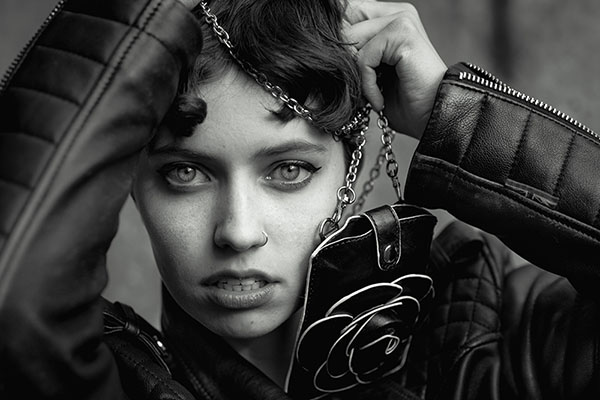
45mm, F/2.2, 1/320th sec., ISO 100
Click image to view larger
Just six months after I started dabbling in digital photography, I took this picture with Nicole. I'd just received that Tamron 45mm lens the day before, and this was my first shoot with it. We were under an overpass in Clinton, New Jersey, and based on the leather jacket she was wearing and the little leather purse she was carrying, I thought it would be cool to shoot it in black and white as an editorial-style photo for leather goods.
Right around that time, I had learned about the concept of subframing—basically creating a picture within a picture using elements in the frame. I'll often use someone's hair for that purpose, but Nicole didn't have a lot of hair, so we used the chain from her purse, which she held up near her face. I ended up calling this photo "Chromatic Chain," mainly because of the high-contrast chromatic aberrations in the chain itself. That was the first thing that popped out at me.
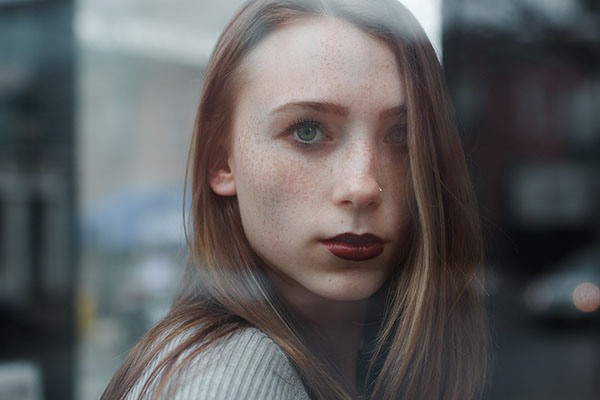
45mm, F/2.5, 1/125th sec., ISO 100
Click image to view larger
This photo of my friend Kallie was when I first started experimenting shooting my subjects through glass. I love taking pictures through windows or other glass panels, using the frames to subframe my subjects. This photo was only the second time I'd done it. It was an overcast, cold day, and I tried to keep the composition simple: just her and a bit of reflection from the street outside. It's a very cool-toned photo, which is why I was glad to get those warmer car headlights in the lower right of the frame to add some contrast.

45mm, F/2.2, 1/320th sec., ISO 100
Click image to view larger
I also shot through glass for this photo of my friend Grace. Before I took it, I'd seen an image that used negative space well, and got me to thinking about how I could experiment with that technique. I usually don't use a lot of negative space in my photos, because I tend to fill the frame with my subject's face, but I wanted to push myself to do something different. I had Grace stand in this glass building while I went outside. Then I got really close to the glass and covered three-quarters of the lens with the door frame, using that frame to push the viewer's eyes to the dark space on the left—your eye naturally wants to gravitate toward the darker areas of the picture. It just pushes your eye right to her face.

45mm, F/2.5, 1/640th sec., ISO 100
Click image to viwe larger
I was photographing my friend Isabel in the park, and I wasn't really happy with the photos I was getting. We were sitting on a bench on a bridge when the wind blew really hard, and it threw her hair back, just as I was telling her a joke. I couldn't resist getting a shot of this totally candid, spontaneous moment. Even though Isabel has beautiful, fiery red hair, I ended up converting the photo to black and white because the color in this photo just wasn't working—it was an overcast day, and the greens were just muddy and blown out. Having it in black and white worked, too, because it forces you to notice the texture of her sweater, which maybe you wouldn't have if the photo were in color and her hair was the main attraction.
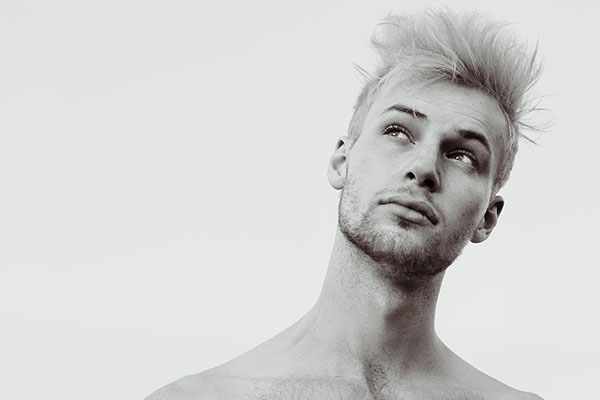
45mm, F/4, 1/250th sec., ISO 800
Click image to view larger
This pic is of Justin Crail, a founder of the Strictly Original production house, which specializes in film, photography, and fashion. He's a good friend of mine, and also a photographer, and we were hanging out one day in my front yard just chilling and taking some photos when I captured this one of him—he says it's his favorite picture ever taken of him. I got low and went a little outside my comfort zone by not putting him directly in the center of the composition. I liked how he was leaning out of the frame, yet still looking back into it, which draws your eye up and back down. It was a shot taken totally by accident, but it really works.
This photo also allowed me to use a little trick I pull out when I want a white background outside of the studio. I simply look for a spot in the sky where there are no clouds. Then, when I convert it to black and white, I ramp up the highlights, and voila—white background.

45mm, F/2.2, 1/250th sec., ISO 100
Click image to view larger
This photo of my friend Danielle, taken during golden hour, has been processed and reprocessed. It's one of the most heavily processed photos I've ever taken—I just couldn't get the colors to work. It's not heavily Photoshopped, though; it just took me a long time to get the colors to behave. Initially the image was very green and yellow and made her look like a Disney character. It took a long time, but I finally managed to fix it all. What I love about this photo is how clear and sharp her eyes are—that intensity is what makes this picture. The sun here is exactly parallel to her face as it set in the canyon.
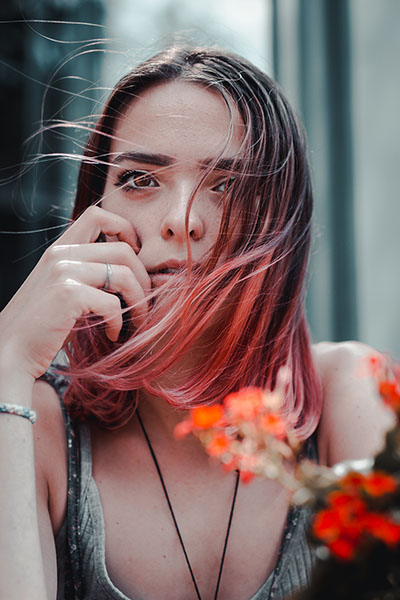
45mm, F/2.2, 1/400th sec., ISO 100
Click image to view larger
Grace hooked me up one more time for this recent photo. This is the same store in Flemington, New Jersey, where I took the picture of Kallie. Once again, it was an overcast day where I wasn't really happy with the pictures I was initially getting, and we were standing in between two buildings when a gust of wind swept through. It pushed her hair across her face, and when she went to brush it back, I realized that it looked really cool in front of her face like that. I figured more wind would come through there, so I had her wait motionless for a couple more minutes, and sure enough, the wind kicked in again. While that was happening, I had her put her hand up to her cheek the way you see here. I especially like the way those strings of hair travel across her face and frame her eyes.
To see more of Connor Williams' work, check out his Instagram and website.
